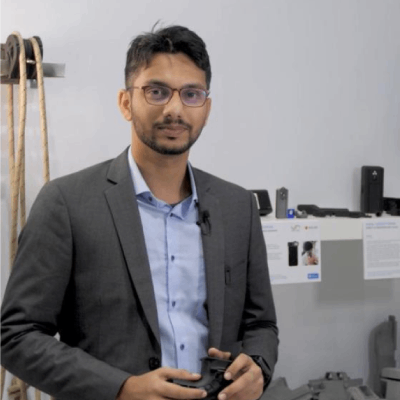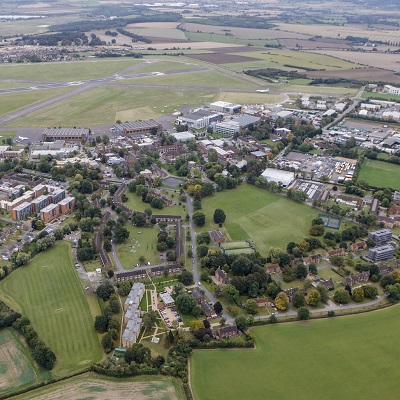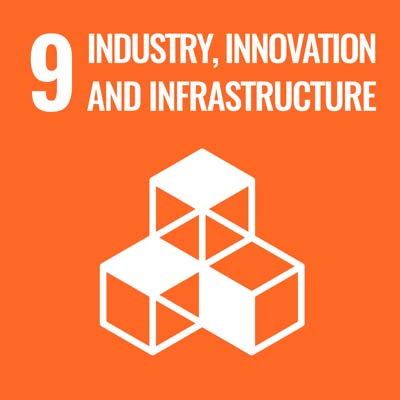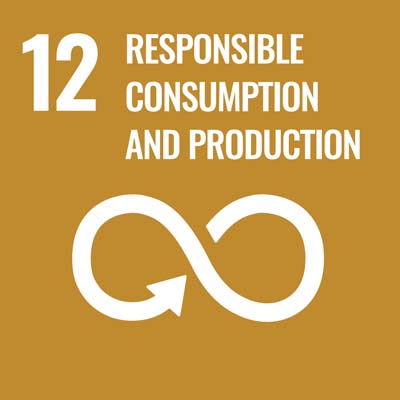Contribute to the future of sustainable manufacturing by specialising in metal additive manufacturing processes, capabilities, system design and modelling. This MSc delivers the specialist knowledge, skills and experience required to work in this cutting-edge field, enabling you to become part of the bigger sustainability landscape.
Metal additive manufacturing holds the potential to revolutionise the way we manufacture products, reduce material waste, energy consumption, and transportation emissions, while also enabling the production of lightweight and complex parts that would be difficult or impossible to produce using traditional manufacturing methods. Metal AM technologies play an important role in improving the sustainability of a range of industries, including the production of lightweight parts in aerospace, automotive and medical industries. During the course, you will gain practical experience through assignments as well as group and individual projects carried out in close collaboration with leading industrial technology suppliers and end-users. Access to state-of-the-art equipment and facilities, such as one of the world's largest metal 3D printers, will allow you to develop industry-relevant skills and contribute to the development of innovative and sustainable applications for this technology.Overview
- Start dateFull-time: October. Part-time: throughout the year
- DurationMSc: Full-time one year Part-time up to three years; PgDip: Full-time up to one year Part-time two years; PgCert: Full-time up to one year Part-time two years.
- DeliveryTaught modules 40%, Group project 20% (dissertation for part-time students), Individual project 40%
- QualificationMSc, PgDip, PgCert
- Study typeFull-time / Part-time
- CampusCranfield campus
Who is it for?
This MSc is for students with suitable backgrounds in science and engineering who are keen on learning new manufacturing technology. Typically, students hold degrees in subjects such as mechanical engineering, materials engineering and they may have work experience in different industries for several years.
Why this course?
Metal additive manufacturing has the potential to revolutionise manufacturing by reducing material waste, increasing design freedom and providing the ability to produce complex parts that would be difficult or impossible to produce using traditional methods.
At Cranfield University, you will benefit from over 20 years’ experience in large-scale additive manufacturing of metallic structures on all fronts such as:
- Process design and modelling
- Incorporation of ancillary processes (cold work, metrology, inspection)
- Development of specialist hardware and CAM software
- Qualification of material properties and definition of design and manufacturing rules.
As a student, you will gain access to our state-of-the-art additive manufacturing facilities including Wire + Arc AM systems (based on robotic arms), CNC gantries, laser-wire additive manufacturing systems and powder-based systems. Cranfield University also has one of the largest metal 3D printers ever made. This enables the production of metal parts at significantly reduced time and cost when compared to existing methods.
You will also get experience across a range of materials, including alloys such as titanium, aluminium, iron, nickel and copper-based systems as well as exotic elements such as tungsten, molybdenum, and tantalum.
The teaching and project work draws knowledge from a team of approximately 30 people, and you will have the chance to work on projects within the WAAMMat consortium. This currently includes 20 industry partners (including Airbus, BAE SYSTEMS, Lockheed Martin and more). Find out more about WAAMMat.
Discover the unique facilities available to you as a student on this course.
Part-time route
We welcome students looking to enhance their career prospects whilst continuing in full-time employment. The part-time study option that we offer is designed to provide a manageable balance that allows you to continue employment with minimal disruption whilst also benefiting from the full breadth of learning opportunities and facilities available to all students. The University is very well located for visiting part-time students from all over the world and offers a range of library and support facilities to support your studies.
As a part-time student you will be required to attend teaching on campus in one-week blocks for three modules, while both in-person and distance learning options are available for other four modules. For a total of seven taught modules, six to be delivered in one week for each and one in two weeks, an overall duration that you are with us would normally be 2-3 years. Teaching blocks are typically run during the period from October to March, followed by independent study and project work where contact with your supervisors and cohort can take place in person or online. The project work could be also conducted in students’ companies or organisations, providing further study flexibility. Students looking to study towards the MSc will commence their studies in the October intake whereas students who opt for the research-based MSc by Research may commence either in October or January.
We believe that this setup allows you to personally and professionally manage your time between work, study and family commitments, whilst also working towards achieving a Master's degree.
The Metal Additive Manufacturing MSc at Cranfield provided me with theoretical and practical exposure to develop an in-depth understanding of the subject which helped me immensely to secure a job in the Additive Manufacturing field.
As a part-time student, I was pleased to cover many topics throughout the Metal Additive Manufacturing MSc, which directly related to many challenges I faced with Additive Manufacturing development at my company. I enjoyed the flexibility the course offered, and combining a work-based problem with the individual research project was a real benefit.
Cranfield University stands out as a premier institution offering a unique Metal Additive Manufacturing course. This intensive one-year program is facilitated by leading experts specializing in the Direct Energy Deposition (DED) process. Meticulously designed to align with industrial demands, the course offers comprehensive insights into this field.
The curriculum encompasses a diverse range of challenging projects, fostering profound learning experiences intertwined with cutting-edge advancements in the Additive Manufacturing sector.
For individuals aspiring to forge a career in Metal AM, I wholeheartedly endorse this program as an invaluable stepping stone.
Informed by Industry
The course was meticulously crafted in collaboration with key stakeholders across various sectors. Our industrial partners continue to contribute to developing sponsored projects as well as keeping the course content relevant and industry-focussed. This strategic approach ensures that the university education is seamlessly aligned with industry needs and best practices.
Course details
The course includes seven taught compulsory modules, which are generally delivered from October to March. The modules include lectures and tutorials, and are assessed through practical work, written examinations, case studies, essays, presentations and tests. These provide the 'tools' required for the group and individual projects.
Course delivery
Taught modules 40%, Group project 20% (dissertation for part-time students), Individual project 40%
Group project
The group project experience is highly valued by both students and prospective employers. Teams of students work to solve an industrial problem. The project applies technical knowledge and provides training in teamwork and the opportunity to develop non-technical aspects of the taught programme. Part-time students can prepare a dissertation on an agreed topic in place of the group project.
Industrially orientated, our team projects have support from external organisations. As a result of external engagement, Cranfield students enjoy a higher degree of success when it comes to securing employment. Prospective employers value the student experience where team working to find solutions to industrially based problems are concerned.
Example of recent group projects from related courses include:
- WAAM of 15-5 PH stainless steel using Plasma arc process
- In-process cold-work of WAAMed aluminium to eliminate porosity
- Laser Interferometric Technology to Monitor Additive Manufacturing
Individual project
Students select the individual project in consultation with the Course Director. The individual project provides students with the opportunity to demonstrate their ability to carry out independent research, think and work in an original way, contribute to knowledge and overcome genuine problems.
Example of recent individual thesis projects from related courses include:
- Electrical property characterisation of copper and aluminium components made by additive manufacturing
- Relationships between build rate and mechanical properties in Ti-6-Al-4V
- Study of building horizontal and inclined walls using additive layer manufacture
Modules
Keeping our courses up-to-date and current requires constant innovation and change. The modules we offer reflect the needs of business and industry and the research interests of our staff and, as a result, may change or be withdrawn due to research developments, legislation changes or for a variety of other reasons. Changes may also be designed to improve the student learning experience or to respond to feedback from students, external examiners, accreditation bodies and industrial advisory panels.
To give you a taster, we have listed the compulsory and elective (where applicable) modules which are currently affiliated with this course. All modules are indicative only, and may be subject to change for your year of entry.
Course modules
Compulsory modules
All the modules in the following list need to be taken as part of this course.
Operations Management
| Aim |
To introduce you to the core factors of managing operations and the concept of flow in operations. |
|---|---|
| Syllabus |
• An introduction to manufacturing organisations and functions. • The theory of operations, flow in manufacturing and what enables/inhibits it. • Order winners, Order qualifiers, and competitive priorities. • Key Performance Indicators in manufacturing. • Product/Process matrix, facility layouts, production strategies, product families. • Customer Demand and capacity planning, and standardization. • Process flow diagrams, and value stream maps. • S&OP, Master Production Scheduling, BOM, and scheduling rules. • Push vs Pull production. • Information systems; MRP, MPRll, ERP, and Kanban systems. • Maintenance management strategies. • Dimensions of Quality, Quality management frameworks, and the cost of quality. • Roles of inventory; inventory management systems and measures. • Lean Manufacturing. • Class discussion of cases, exercises, and videos to support this syllabus. |
| Intended learning outcomes |
On successful completion of this module you will be able to: 1. Discuss the importance of the operations functions of an organisation and how operations performance can impact the success of the whole organisation. 2. Assess production and capacity management strategies that can be deployed to meet customer demand for products and services. 3. Assess the importance of inventory, maintenance, and quality management systems in achieving high levels of operational performance. 4. Determine the role of information in planning, control, and scheduling, including the role of IT systems. 5. Critique the different attributes of the Lean Production System and how they apply to contemporary operational contexts. |
Metal Additive Manufacturing Metallurgy
| Aim |
|
|---|---|
| Syllabus |
• Crystal structure of metals. • Dislocations and strengthening mechanisms. • Mechanical properties of metals. • Grain structure and recrystallisation. • Phase Diagrams. • Phase transformations: Development of microstructure and alteration of mechanical properties. • Physical metallurgy of Steel/Stainless Steels/Nickel/Aluminium/Titanium and impact of additive manufacture on microstructure and mechanical properties of these alloys. • Intermetallic compounds. • Residual stress. • Dissimilar AM. • Corrosion. |
| Intended learning outcomes |
On successful completion of this module you should be able to: 1. Demonstrating understanding on crystal structure of some structural and functional alloys, analyse phase diagrams and continuous temperature transformation diagrams to explain the microstructural changes and strengthening mechanism for different alloys. 2. Demonstrate understanding on the impact of deposition processes and in-process working on microstructural characteristics of structural alloys and correlate with their mechanical properties. 3. Evaluate advanced materials such as intermetallic compounds developed by AM process for different applications. 4. Evaluate defects in an AM part and correlate to the processing parameters. |
Metal Additive Manufacturing Processes
| Aim |
|
|---|---|
| Syllabus |
• Fundamentals of arc processing. • Fundamental of laser/beam processing. • Different established AM processes. • Metal AM processes. • AM process selection. • Net and near net shape manufacture. |
| Intended learning outcomes |
On successful completion of this module you should be able to: |
Additive Manufacturing System Design
| Aim |
This module will enable you to design their own additive manufacturing cell (including manipulation equipment, and sensing), or integrate an existing additive manufacturing machine in a broader production line. It also introduces you to experimental design and how to develop suitable parameters for part production. |
|---|---|
| Syllabus |
• Sensors for Additive manufacturing. • Manipulation. • Jigs and fixtures. • Cell design. • Project planning. • Factory layout. • Experimental design. • Component shielding. • Thermal management. • Costing and life cycle analysis. • Statistical methods towards process control and optimisation. • Generation of technical reports and research work. |
| Intended learning outcomes |
On successful completion of this module you should be able to: 1. Design and justify a programme of experiments for producing a simple structure and demonstrate the effect of the main input parameters, and analyse data produced from these experiments so that the relationship between process inputs and outputs is understood. 2. Plan an AM cell for manufacturing a specific AM part that includes selection of a robot, and methods to manipulate the part, fixturing and sensing of the part, equipment for loading and unloading, labour requirements and an estimation of the time to manufacture. 3. Calculate and justify the cost of a typical additive manufacturing operation including labour costs, overhead costs, and consumable costs. 4. Plan a factory layout that incorporates all required operations (feedstock storage, machine preparation, material preparation, AM cell and the finishing operations for the part). 5. Construct a project plan for the installation of the AM system. |
Finite Element Analysis for Additive Manufacturing
| Aim |
|
|---|---|
| Syllabus |
|
| Intended learning outcomes |
On successful completion of this module you should be able to: 1. Appraise finite element analysis (FEA) method and its applications. 2. Evaluate considerations for applying FEA to the modelling of metal additive manufacturing. 3. Identify and discuss the limitations and errors associated with the use of FEA. 4. Demonstrate and justify a FEA approach for solving a range of mechanical and thermal problems. 5. Create a FEA model to simulate additive manufacturing process and critically assess the results. |
Management of Manufacturing Quality
| Aim |
|
|---|---|
| Syllabus |
• Overview of standards and their function. • Introduction to quality assurance. • Quality control during manufacture. • Operator qualification. • Application of Non-destructive examination (NDE) to characterise different types of defects on AM processes Non-destructive testing methods (dye penetrant, magnetic particle, eddy current, acoustic emission, radiographic inspection, tomography, ultrasonic inspection). • Destructive testing methods. • Industrial case studies. • Health and safety. |
| Intended learning outcomes |
On successful completion of this module you should be able to: 1. Appraise the standards and the relationship between standards and a particular application, to achieve the required quality; feedstock characteristics and quality. 2. Assess the different NDT and DT, explain the principles upon which they are based, and interpret their results. 3. Assess the probability of occurrence of the different defect types for a selection of materials and manufacturing techniques. 4. Manage workplace practices to ensure adequate health and safety. |
Post Processing for Additive Manufacturing
| Aim |
|
|---|---|
| Syllabus |
• Post-processing techniques. • Cold working. • heat treatments. • Hot isostatic pressing. • Machining of near net shape. • Repair principles and methods. • Impact of processing on materials. |
| Intended learning outcomes |
On successful completion of this module you should be able to: 1. Evaluate the different post processing techniques used on AM parts, including those required for removal of support structures, improvement of surface characteristics and structural integrity. This should include requirements during AM building that a part needs to comply. 2. Appraise the benefits and limitations of each post processing technique with respect to each AM process. 3. Propose the most suitable post processing technique including heat treatment (for stress relieving and ageing) for a specific AM process and application. 4. Assess the benefits of in-process cold work and on the properties and microstructure of parts. |
Teaching team
You will be taught by industry-active research academics from Cranfield with an established track record, supported by visiting lecturers from industry. The Course Director for this programme is Dr Yongle Sun and the Admissions Tutor for this programme is Surya Krishnaswamy.
Accreditation
This MSc course is accredited by;
- The Institution of Mechanical Engineers (IMechE) on behalf of the Engineering Council as further learning for CEng until August 2026.
- The Royal Aeronautical Society (RAeS) until August 2026 on behalf of the Engineering Council as further learning for CEng.
Candidates must hold a CEng accredited BEng/BSc (Hons) undergraduate first degree to show that they have satisfied the educational base for CEng registration.
Please note accreditation applies to the MSc award, PgDip and PgCert do not meet in full the further learning requirements for registration as a Chartered Engineer.
Your career
This qualification takes you on to a wide range of careers involving metal additive manufacturing processes, with experts needed in all fields from design, processes or simulation. Responsibilities include research, development, design, engineering, consultancy and management across a broad range of industrial sectors.
Students in the past have gone on to hold positions including:
| Additive Manufacturing Engineer |
| Applications Engineer |
| Design Engineer |
| Research Assistant |
Companies that our students work for include:
| Rolls-Royce | Wayland Additive |
| GKN Aerospace | Addept3D |
| WAAM3D |
Cranfield’s Career Service is dedicated to helping you meet your career aspirations. You will have access to career coaching and advice, CV development, interview practice, access to hundreds of available jobs via our Symplicity platform and opportunities to meet recruiting employers at our careers fairs. Our strong reputation and links with potential employers provide you with outstanding opportunities to secure interesting jobs and develop successful careers. Support continues after graduation and as a Cranfield alumnus, you have free life-long access to a range of career resources to help you continue your education and enhance your career.
How to apply
Click on the ‘Apply now’ button below to start your online application.
See our Application guide for information on our application process and entry requirements.
.ashx?h=400&w=400&la=en&hash=868A99BD8415DD1CC0508A4B2857EED1636D4573)
.ashx?h=400&w=400&la=en&hash=927AC8772594975E7C47EB535F1BECA83006D10B)















